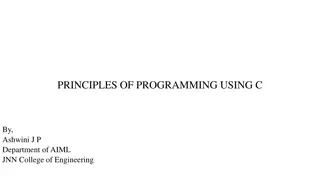Understanding Non-literal Meaning: Idioms, Metaphors, and Metonymy
The unpredictable world of non-literal meaning through idiomatic expressions, metaphors, and metonymy. Discover how these concepts shape language and thought.
3 views • 37 slides
Chemical equilibrium
Chemical equilibrium is a state where reactants and products reach a balance in a reaction. Learn about reversible and irreversible reactions, equilibrium constants, and how they affect chemical analysis. Discover the accuracy and applications of volumetric analysis, including titration methods like
3 views • 13 slides
Principles of Programming Using C
Introduction to C programming language, covering topics such as computers, efficient program design, program structures, files, compilers, variables, constants, input/output statements, compiling and executing programs. Characteristics of computers and their operations are also discussed.
5 views • 104 slides
Understanding Fluid Pressure in Oil Field Hydraulics
Explore the fundamentals of fluid pressure including pressure basics, unit conversion, fluid weight constants, true vertical depth, and hydrostatic pressure in the context of oil and gas technology programs. Learn how to calculate pressure gradients, understand the impact of fluid density on pressur
1 views • 40 slides
Programming in C: Overview and Constants Explanation
Programming in C is a fundamental introductory guide to the C programming language. It covers the basics of C, including its development history, character set, constants, and rules for constructing constants like integer and real constants. Dr. M. A. JAMAL MOHAMED YASEEN ZUBEIR, an Assistant Profes
3 views • 33 slides
Earth-GRAM Overview and Update Status
Earth-GRAM is undergoing significant upgrades including updates to the Global Reference Atmospheric Model suite. The upgrade team aims to modernize code, incorporate state-of-the-art data sources, enhance user support, and address limitations. The team comprises experts from NASA Langley Research Ce
0 views • 22 slides
Understanding Transient Conduction in Heat Transfer
Transient conduction in heat transfer occurs when boundary temperatures change, causing temperature variations within a system until a steady state is achieved. This phenomenon is commonly seen in processes like quenching hot metals. The Lumped Capacitance Method is used to analyze such scenarios, i
0 views • 55 slides
Understanding the Recession Baseflow Method in Hydrology
Recession Baseflow Method is a technique used in hydrology to model hydrographs' recession curve. This method involves parameters like Initial Discharge, Recession Constant, and Threshold for baseflow. By analyzing different recession constants and threshold types such as Ratio to Peak, one can effe
0 views • 8 slides
Understanding Acid-Base Balance in the Body: Importance and Regulation
Acid-base balance is crucial for maintaining optimal health, as slight deviations in hydrogen ion concentration can impact enzyme activity and metabolic processes. The body employs various defense mechanisms to regulate pH levels, involving buffers, lungs, and kidneys. Strong acids release more H+ i
3 views • 48 slides
Understanding Acids, Bases, and Buffers in Medical Biochemistry
Biologically important molecules, such as acids and bases, have significant roles in metabolism. Strong acids like hydrochloric acid ionize completely, while weak acids and bases play crucial regulatory roles. The Bronsted-Lowry theory defines acids as proton donors and bases as proton acceptors. Eq
0 views • 29 slides
Learning Objectives in Mathematics Education
The learning objectives in this mathematics course include identifying key words, translating sentences into mathematical equations, and developing problem-solving strategies. Students will solve word problems involving relationships between numbers, geometric problems with perimeter, percentage and
0 views • 30 slides
Understanding Excel Spreadsheets
Excel is a powerful software program that simplifies number manipulation by organizing data into columns and rows. Each intersection is called a cell, with columns represented by letters and rows by numbers. Cells can contain labels, constants, or formulas, making it easy to analyze and manipulate d
0 views • 28 slides
Evolution of Translation Theory: From Literal to Sense-for-Sense
Western translation theory up to the 20th century revolved around the debate of literal, free, and faithful translation. This discussion traces back to Cicero and St. Jerome and has influenced translation practices for centuries. While some advocated for word-for-word translations, others, like St.
1 views • 13 slides
Introduction to Assembly Language Syntax and Program Data
Learn about the syntax of assembly language and how data, variables, and constants are used in programming. Explore the basic instructions and the translation of high-level language into assembly language. Discover the role of an assembler in translating assembly language programs into machine langu
4 views • 36 slides
Understanding PIC18 Family Instruction Set and Literal Instructions
Exploring the operation and significance of literal instructions in the PIC18 family's instruction set, including examples of bitwise operations like AND, IOR, and XOR. Learn how these instructions affect the status register and how they can be used to manipulate data effectively in programming with
1 views • 44 slides
Understanding Reaction Isotherms and Equilibrium Constants
Explore reaction isotherms and equilibrium constants through Vant Hoff's and Gibbs free energy equations. Learn about the relationship between Gibbs free energy, equilibrium constant, and temperature dependence. Discover how these concepts are applied in determining the direction of chemical reactio
1 views • 18 slides
Understanding Assembler Directives and Symbols in Assembly Language
Assembly language is a low-level programming language used for computers, microprocessors, microcontrollers, and ICs. It consists of instructions and directives (pseudo instructions). Assembler directives are statements that guide the assembler during the assembly process. Categories of directives i
3 views • 39 slides
Understanding Algebraic Expressions: Variables, Coefficients, and Constants
Explore the difference between numeric and algebraic expressions, learn about the components of algebraic expressions - variables, coefficients, and constants. Discover how to identify variables, coefficients, and constants in expressions. Classify algebraic expressions as monomials, binomials, or t
0 views • 20 slides
Literal vs. Deeper Meaning in Character Inferences
Exploring the difference between literal and deeper meanings in character inferences through examples from Romeo and Juliet. By analyzing quotes and events, readers can uncover hidden motivations and emotions behind characters' actions, providing a richer understanding of the story.
0 views • 4 slides
Understanding Lattice Constants in Materials Using DFT Calculations
Using Density Functional Theory (DFT) calculations, we explore how to determine the lattice constant of simple cubic, face-centered cubic (fcc), and hexagonal close-packed (hcp) materials. By fitting numerical data and analyzing energy considerations, we predict lattice constants for various metal s
0 views • 17 slides
An Exploration of Linguistic Meaning: Semantics and Pragmatics
Delve into the realm of linguistic meaning through the lenses of semantics and pragmatics. Explore how words and phrases carry literal meanings, while language usage in social contexts creates both literal and nonliteral meanings. Uncover the intricate interplay between semantics, concerned with the
6 views • 70 slides
Introduction to Floating Point Data Types and Operations
This content delves into the fundamentals of floating-point data types, focusing on single-precision floating-point formats like float, excess-127, and their characteristics. It also compares float and int32_t data types, detailing the representation and conversion of values between them. The materi
0 views • 46 slides
Understanding Figurative Language: A Guide to Metaphors, Similes, and More
Figurative language is a powerful tool used by writers to evoke emotions and create vivid imagery in the minds of readers. It goes beyond literal meanings, allowing for deeper interpretations and connections with the subject matter. This guide explains the difference between figurative and literal l
0 views • 40 slides
Chemistry Review Exercise: Periodic Table and Atomic Properties Review
This detailed content covers a review exercise on the Periodic Table and Atomic Properties of various elements. It includes information on atomic structures, fundamental physical constants, and common elements found in the Periodic Table. The content explores elements from Hydrogen to Osmium, detail
0 views • 16 slides
Understanding Constants in Programming
Constants in programming are values that remain fixed throughout the execution of a program, unlike variables whose values can change. This lesson outline covers the definition of constants, the difference between variables and constants, categories of constants (literal and named), examples of lite
0 views • 18 slides
Understanding Java Programming Concepts: Data, Loops, Variables, and Scope
This content discusses fundamental Java programming concepts such as primitive data types, definite loops, constants, scope, limitations of variables, and scope implications. It also covers the use of class constants to create fixed values visible throughout a Java program.
0 views • 15 slides
Understanding Arithmetic Expressions and Constants in Programming
Learn about the importance of named constants and variables in arithmetic expressions, how to perform assignments with and without expressions, and the implications of working with integer and floating-point arithmetic in programming. Explore examples and exercises to enhance your programming skills
0 views • 26 slides
Understanding Different Types of Constants in Programming
Constants in programming are fixed values that do not change during program execution. They include character, numerical, and string constants. Integer constants can be decimal, octal, or hexadecimal. This article explains each type of constant with examples of decimal, octal, and hexadecimal intege
0 views • 22 slides
Understanding Connotation and Denotation in Language
Connotation and denotation play crucial roles in assigning meaning to words. While denotation refers to the literal dictionary definition of a word, connotation involves the emotional and imaginative associations surrounding it. This distinction is exemplified through words like "house" and "home,"
0 views • 21 slides
Understanding Figurative and Literal Language in English
This comprehensive guide explains the concepts of figurative and literal language, with examples of similes, metaphors, personification, hyperbole, and understatement. Learn how these devices add depth and creativity to writing.
0 views • 32 slides
The Girl in the Lavender Dress: Literal Questions and Inferences
Retold by Maureen Scott, "The Girl in the Lavender Dress" is a mysterious tale that challenges readers with literal questions and inferences about the characters and events. From the unusual girl in a lavender dress to the gripping moments in the car, the story unravels with intriguing textual evide
0 views • 7 slides
Understanding Semantics and Pragmatics: Exploring Extensions of Meaning
This chapter delves into the realms of semantics and pragmatics, exploring literal and non-literal meanings, naturalized, established, and nonce extensions, as well as metaphor and metonymy. It discusses how certain meanings become entrenched in language, either as naturalized or established extensi
0 views • 18 slides
Understanding Precipitation Reactions in Analytical Chemistry
Precipitation reactions play a crucial role in analytical chemistry, where cations and anions combine to form insoluble solids called precipitates. By following solubility rules, scientists can predict these reactions, aiding in identifying ions present in solutions. Properties, formation, and equil
0 views • 17 slides
Approaches to Statutory Interpretation: The Literal Rule
The Literal Rule in statutory interpretation mandates that all words in a statute be given their ordinary and natural meanings, even if the result seems absurd. This approach emphasizes following the clear wording of the law as enacted by Parliament. Advantages include respecting parliamentary sover
0 views • 26 slides
Decoding Common Euphemisms: Literal vs Figurative Meanings
Explore the world of euphemisms by examining common examples used in society. Discover the literal and metaphorical meanings behind euphemisms like "gone to a better place" and "need to powder my nose." Unveil the subtle ways language softens harsh realities through colorful illustrations and explan
0 views • 6 slides
Understanding Constants and Literals in C++ Programming
Constants and literals in C++ are fixed values that the program cannot alter. They come in various types such as integer numerals, floating-point numerals, characters, strings, and boolean values. Integer literals can be decimal, octal, or hexadecimal constants, while floating-point literals have in
0 views • 7 slides
Understanding Numeric Data Types in Programming
Exploring the world of numeric data types, this content delves into the concepts of integers and real numbers in mathematics as well as their representation in computing. It covers the use of literal constants, named constants, and the differences between integers and real numbers. The content also
0 views • 42 slides
Understanding Literal and Non-Literal Meanings of Words and Phrases in 3rd Grade ELA
Literal language refers to the dictionary meaning of words, while non-literal language involves expressions that go beyond literal interpretation, such as idioms. By using context clues, students can distinguish between literal and non-literal meanings, enhancing their reading comprehension skills.
0 views • 14 slides
Understanding Plant Constants in Construction Engineering
This academic piece delves into the significance of plant constants in building and civil engineering construction projects. It discusses the necessity of accurate quotes, reliable quantities, and standards for labor and plant to achieve efficiency and cost-effectiveness. The content emphasizes the
0 views • 19 slides
Understanding Acid-Base Disorders and Blood Gas Analysis
This educational content provides definitions, formulas, and explanations related to acid-base disorders, blood gas analysis, dissociation constants, the Henderson-Hasselbalch equation, and carbonic acid in clinical pathology. Learn about acids, bases, pH, ionization constants, and how these concept
0 views • 35 slides







































